Photos with this report (click to enlarge) | |||
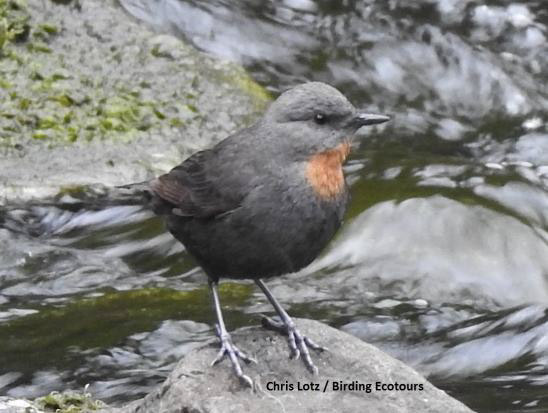 Rufous-throated Dipper |
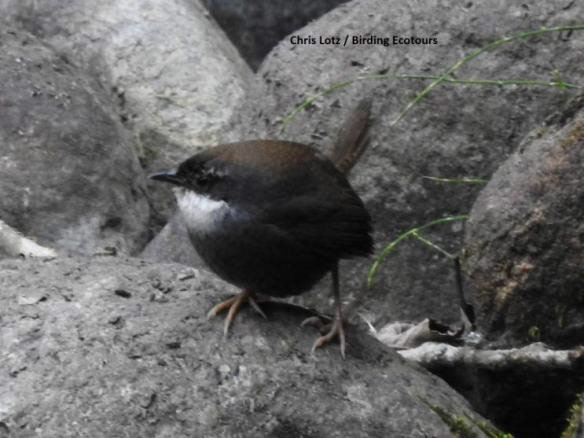 White-browed Tapaculo |
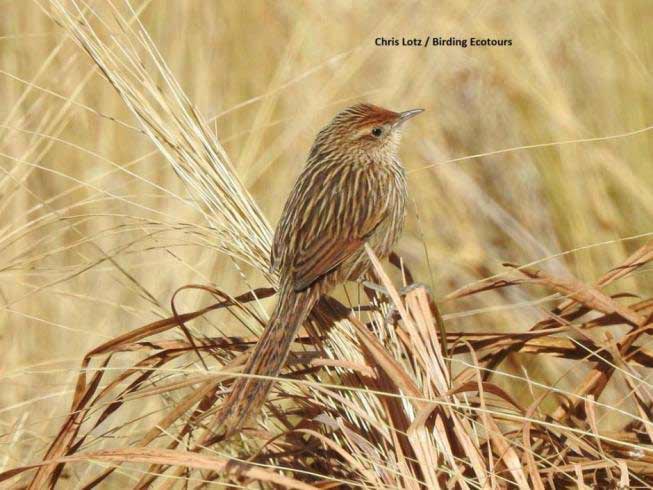 Scribble-tailed Canastero |
|
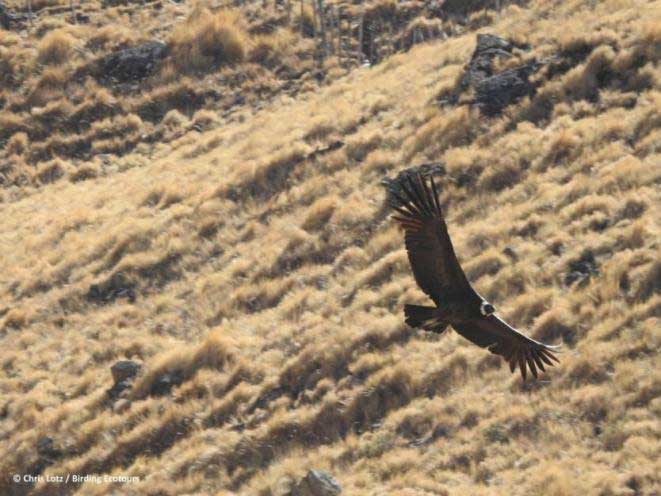 Andean Condor |
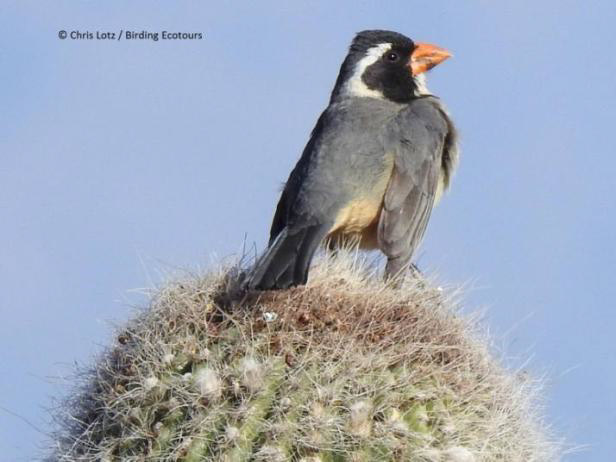 Golden-billed Saltators |
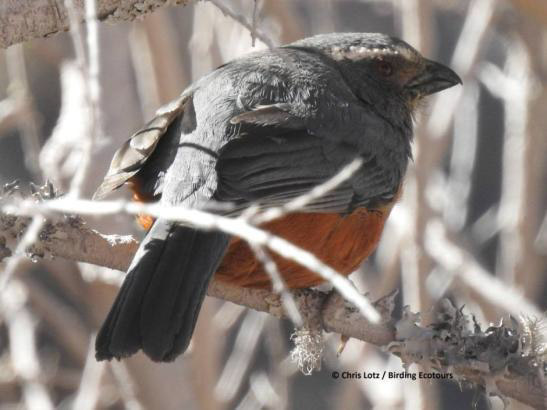 Rufous-bellied Mountain Tanager |
|
My friend Bill Heck and I liked the idea of heading to Argentina for some birding, so why not? It really was that easy: we booked our flights, and the next thing we were there in Argentina, birding (it’s as simple as that). Our schedule did have some constraints, though – we only had about two weeks available, so we chose a manageable part of this large country, the northwest. And we were only able to do this in September due to other commitments later in the year; while this meant missing some of the more widespread migrants (too early), and thus a shorter overall bird list, we nevertheless managed to see the large majority of the “real” targets, i.e. the localized birds tough to find outside of northwest Argentina and southern Bolivia. We started the trip in Tucuman and finished it in San Salvador de Jujuy. We traversed the famous wine-growing region of Argentina, with its amazingly diverse and spectacular scenery. Since we had to fly via Buenos Aires and had a few hours there before and after the main trip, we also saw quite a few of the species common around this huge city of 16 million people (but not occurring in north-west Argentina).
Day 1, 11 September 2017. Arrival in Buenos Aires, flight to Tucuman and an introduction to high altitude birding
After an overnight flight from Columbus, Ohio (via Houston) we arrived tired but excited in Buenos Aires. We had to drive across the city to the domestic airport, lapping up the interesting sights as well as a large number of birds – Buenos Aires is a “birdy” city, for sure. Many of the species were common Argentinian/South American birds such as Monk Parakeet, Chimango Caracara, Southern Lapwing, Picazuro Pigeon, Guira Cuckoo, White-rumped Swallow, Chalk-browed Mockingbird, Rufous-bellied Thrush, Shiny Cowbird, and of course the all-too-common (but attractive) Rufous-collared Sparrow (which we saw daily, as one does in most birding tours anywhere in South America). On the last day of our trip, when we were back in Buenos Aires, we focused on getting less widespread birds such as two species of swan; more on that later.
We then flew to Tucuman, and on arrival there we immediately started ascending to Tafi del Valle, where we were to spend the night. We saw a Firewood-gatherer (of the avian variety) just outside of Tucuman before we got into the Alder Forest/Yungas/Cloud Forest zone. Here stacks of brilliant birds awaited us, including Torrent Duck (easy to see in north-western Argentina), the Argentinean endemic Yellow-striped Brushfinch, Rusty-browed Warbling Finch, Yellow-billed Teal, Dusky-legged Guan, Cream-winged Cinclodes, Mountain Wren, Brown-capped Whitestart, and many others. The highlight, however, was getting pretty good views of White-browed Tapaculo (and getting “pretty good” views of a tapaculo is not always easy)!
Day 2, 12 Sep. Birding the high altitudes: El Infiernillo, El Mollar, and the Yungas again
What a spectacular day! After breakfast we ascended above the tree line to bird El Infiernillo pass. En route to our first birding stop we found a couple of Burrowing Owls sitting atop fence posts, along with a flock of neat-looking Black Siskins. When we reached the first stakeout, things only got better. The highlights here were two Argentinean endemics, Moreno’s Ground Dove (in addition to Black-winged Ground Dove) and Tucuman Mountain Finch. The supporting cast included several other finches, such as the attractive Rusty-browed Warbling Finch and our first Sierra Finches (Plumbeous and Ash-breasted). Other amazing birds also pitched up, one by one. For example, we got fantastic views of a majestic Cinereous Harrier quartering low over the high altitude grassland, saw some of our first Southern Crested Caracaras, and enjoyed close-up views of Buff-breasted Earthcreeper.
We then drove on a little further and hiked up to our Scribble-tailed Canastero stakeout. It was hard work getting to the site, but we were richly rewarded with a pair of displaying canasteros. What a bird, and what a great name it has! Interruptions are rarely pleasant, but when a close-flying Andean Condor is what interrupts one, it’s certainly excusable. Condors proved pretty easy to see throughout our northwestern Argentina route, so in retrospect perhaps we didn’t have to allow this first condor to interrupt our canastero viewing.
On the hike to the canastero stakeout we also encountered Cinereous Ground Tyrant and White-winged Cinclodes along with the much more common Cream-winged Cinclodes (which put in appearances all over the place throughout our Argentina trip).
We found a good number of birds with “Andean” in their names today, not just the Andean Condor but also Andean Swift, Andean Flicker, and in the afternoon at an artificial lake called El Mollar (Dique La Angostura) also Andean Goose, Andean Gull, and Andean Coot.
The late afternoon was well-spent as we managed to find a pair of Rufous-throated Dippers building a nest when we ventured to lower elevations below the tree line again. What a bird! Incidentally, I got some video footage of this species from later in the trip, which is now on the Birding Ecotours YouTube channel. It’s well worth a watch, as dippers are always amazing, and one keeps getting flashes of the striking reddish throat in this video.
Day 3, 13 Sep. Tafi del Valle to Cachi, birding the western slope to Amaicha del Valle and the Río Santa Maria
We crossed over the high mountains (El Infiernillo) again. We had to be self-disciplined enough not to stop for birds we had already seen before, as we wanted to get to the dry habitat of the rain shadow on the far side of the pass early enough to bird it during peak time. And our plan worked well, as we found the bulk of our targets without problems. We got great views of Burrowing Parrots, close-up Cliff Flycatcher, and Greyish Baywing (Bay-winged Cowbird) as we drove toward our main birding sites. Our list of Canasteros rose to five species (it became to be six by the end of the trip) with the addition of the endemic Steinbach’s and several of the more numerous Rusty-vented. Green-barred Woodpecker (which is basically a flicker – the same genus – but more arboreal than most flickers) and Golden-billed Saltator seemed to enjoy sitting atop the giant cardon cacti. We encountered many other very exciting species, including Brown-capped Tit-Spinetail, Tufted Tit-Spinetail, Streak-fronted Thornbird, Yellow-billed Tit-Tyrant, noisy Greater Wagtail-Tyrant, Patagonian Mockingbird, White-fronted Woodpecker, Checkered Woodpecker, Grey-hooded Sierra Finch, a lot of Common Diuca Finches, pretty Rufous-sided and Ringed Warbling Finches, Greenish Yellow Finch, and last but definitely not least the endemic White-throated Cacholote (a really strange bird).
Day 4, 14 Sep. Cuesta del Obispo (Bishop’s Slope) to Salta via Los Cardones National Park
We started the day with our first of many Blue-and-yellow Tanagers just as we were about to leave our hotel. We then embarked on an amazing drive. The scenery throughout this tour was as varied as it was spectacular. Today it seemed like the scenery got even better than on previous days, if that is possible. Moreover, the rate at which we were adding new birds was not slowing down in any way – by now it was already evident that habitats (and the resulting suites of bird species) change unusually fast in northwestern Argentina.
We found our first hummingbirds today, the peculiar White-sided Hillstar (which often perches to feed or combines hovering with perching – strange for a hummer) and the truly spectacular Red-tailed Comet, one of the most marvelous-looking hummingbirds I have ever laid eyes on.
Parrots were - as always during this whole trip right until the final day - much in evidence, and we added two new ones to our list today, Grey-hooded Parakeet and Scaly-headed Parrot.
Northwestern Argentina is a furnariid paradise, and we added more of them today in the form of Rufous-banded Miner and Rock Earthcreeper. Other good species we saw today included Tufted Tit-Tyrant, Black-billed Shrike-Tyrant, our first Mourning Sierra Finch, and many others.
Probably the highlight of the day, however, was seeing the localized, Near-threatened (IUCN) Rufous-bellied Mountain Tanager (previously called Rufous-bellied Saltator and now placed in the genus Pseudosaltator).
Zimmer’s Tapaculo tantalized us with some very close-singing individuals, but we never did manage to lay eyes on one – this was truly bad luck as this species is known to sometimes co-operate really well.
We spent the night at Hotel Selva Montana in Salta.
Day 5, 15 Sep. Salta to Joaquin V. González via Palomitas and Rio Juramento (Chaco-habitat dirt roads we birded)
Hotel Selva Montana proved to be a difficult place to pull away from, especially since its gardens tantalized us with some cloud-forest-type birds which were new for us. So we spent perhaps an hour after breakfast birding the hotel garden and the surrounding affluent suburbs and found brilliant birds, including Plush-crested Jay, Grey-necked Wood Rail, White-bellied Hummingbird, Rough-legged Tyrannulet (our list of tyrannulets growing nicely as we’d already seen a few other species before today; please refer to the bird list at the end of this report as not all species are mentioned in the text), Smoke-colored Pewee, gorgeous Cream-backed Woodpecker, Golden-winged Cacique, tame and beautiful Tropical Parula, and many others.
We then drove for a while to bird two amazing dirt roads, both of which gave access to the arid Chaco habitat, adding a suite of spectacular birds to our list (which tends to happen when one finds oneself in a new habitat). One of the biggest highlights at our first birding site of the day (Palomitas) was getting multiple views of Black-legged Seriemas (which also spent a lot of time calling (or “singing” if non-songbirds/passerines can actually be said to do this) as well as a pair of Red-legged Seriemas striding across a patch of grassland within the Chaco woodland. A White-barred Piculet showed really well at one point. Pretty little Masked Gnatcatchers were everywhere. Stripe-crowned Spinetail and Little Thornbird, Narrow-billed Woodcreeper, Variable Antshrike, Southern Beardless Tyrannulet, many Suiriri Flycatchers, Pearly-vented Tody-Tyrant, a great many Black-capped Warbling Finches, etc., were all added to our growing bird list.
Our second birding site for the morning was another dirt road leading to a bridge over the Rio Juramento, and this road was just as productive as Palomitas. Birds were spectacular, and included Many-colored Chaco Finch and Ultramarine Grosbeak. We were surprised to see an undomesticated-looking Muscovy Duck well away from any human habitation, so we assume it was indeed a wild one sitting on the bank of Rio Juramento. We enjoyed seeing some Chaco Chachalacas along with some Buff-necked Ibises, a Green Kingfisher, and several other birds also along the river.
On our way back to the main road after the bridge we managed to locate a close-up Chaco Puffbird – this turned a brilliant day into a spectacular day!
Day 6, 16 Sep. Full day birding quebracho woodlands around Taco Pozo
This was yet another highly, highly productive day in terms of adding new trip birds. We spent the full day in well-developed quebracho woodland, which seemed to have completely different birds compared to the similar, but not quite the same, type of Chaco woodland of the previous day. Just to emphasize how spectacular today was, we’d already thought “what an incredible, amazing day” when the last hour of light led to one of the most memorable events of the whole trip. Just imagine the atmosphere being set by hundreds of prehistoric-looking Chaco Chachalacas coming to the road verge in the late afternoon. Then four Quebracho Crested Tinamous suddenly appeared in the road ahead of us, followed soon thereafter by a Black-bodied Woodpecker! I shouldn’t have started with the end of the day, but I do wish to emphasize these birds.
Moving back to the beginning, we added new birds to our list constantly and at quite a rapid pace throughout the day. Crested Gallito showed well but did not provide the best photo opportunities.
We also started seeing things like Lark-like Brushrunner, Brown Cacholote, Crested Hornero, Red-crested Cardinal, hundreds of Monk Parakeets, Blue-crowned Parakeet, Turquoise-fronted Amazon, a pair of Spot-winged Falconets, Chaco Earthcreeper (which worked us very hard!), and Short-billed Canastero.
Woodcreepers abounded, including the insane-looking Red-billed Scythebill, humungous Great Rufous Woodcreeper, ground-loving, hoopoe-like Scimitar-billed Woodcreeper, and dainty Narrow-billed Woodcreeper.
Our list kept growing. Today we also added Stripe-backed Antbird and two new hummingbirds, Glittering-bellied Emerald and Blue-tufted Starthroat. A large number of other fine species entertained us – Straneck’s Tyrannulet, Cinereous Tyrant, Rufous Casiornis, Brown-crested Flycatcher, and White-banded Mockingbird were some of them.
Mammal-wise, we saw a cavy today.
Day 7, 17 Sep. Drive to the small town of Calilegua near Calilegua National Park
While this was basically a travel day to get to the cloud forests of the amazing Calilegua National Park area (where we were about to spend three nights), we did manage to find a large number of star birds during short stops along the road. Grasslands during the first section of our drive represented a new habitat for us; so, needless to say, there were new species awaiting us here. At one point we encountered a small flock of Greater Rheas. At another stop we got fantastic scope views of a singing Grassland Sparrow and saw Pampa Finches and Grassland Yellow Finches that needed no scope as they were right next to the road. We also saw Burrowing Owl. Cattle Tyrant also made an appearance today.
Bridges along the route were very productive and generated species such as Brazilian Teal, Bare-faced Ibis, Collared Plover, the North American migrant White-rumped Sandpiper, Amazon Kingfisher, Sooty-fronted Spinetail, Yellow-chinned Spinetail, beautiful Yellow-billed Cardinal, and various other desirable birds.
In wooded habitats en route we saw a new hummer for the trip, Gilded Sapphire, along with Rufous-fronted Thornbird, Olivaceous Woodcreeper, Great Antshrike, Barred Antshrike, Sooty Tyrannulet, Yellow-olive Flatbill, White-browed Blackbird, Crested Oropendola, Chestnut-vented Conebill, Greyish Saltator, and (as always!) a lot of others. One of the highlight birds was, strangely, a very drab-looking species – we waited patiently for it to “sing” and provide close views before we could clinch its ID – Dull-colored Grassquit.
Bill saw a Giant Wood Rail along the roadside at one point today.
Last but not least, arriving at the hotel which we would call “home” for the next three nights, we were treated to the Vulnerable (IUCN) Bolivia/northern Argentina endemic Tucuman Amazon, along with equally beautiful Golden-collared Macaws and Toco Toucan. All these species were feeding in stunningly colorful coral trees. Purple-throated Euphonia enjoyed the mistletoe of the same coral trees.
A noteworthy mammal we saw today was crab-eating fox (nice close views).
Day 8, 18 Sep. Calilegua National Park
We spent a full day in this wonderful national park looking for cloud forest species. We added a couple of spectacular eagles to our list, Solitary Eagle and a beautiful Black-and-white Hawk-Eagle. Yungas Manakin was one of the really good birds of the day. Blue-crowned Trogon showed well, as did Amazonian Motmot. Smoky-brown Woodpecker and Golden-olive Woodpecker were both new for the trip. Ochre-cheeked Spinetail worked us very hard but eventually rewarded us with super views on and near the ground next to us. We also found Azara’s Spinetail, Buff-browed Foliage-gleaner, Black-banded Woodcreeper, Sclater’s Tyrannulet, White-throated Tyrannulet, Mottle-cheeked Tyrannulet, Grey Elaenia, Highland Elaenia, Ochre-faced Tody-Flycatcher, Euler’s Flycatcher, fabulously beautiful Spotted Nightingale-Thrush, Glossy-black Thrush, Andean Slaty Thrush, Pale-legged Warbler, Two-banded Warbler, Saffron-billed Sparrow, Fulvous-headed Brushfinch, White-browed Brushfinch, and Red Tanager in the park. White-throated Antpitta also worked us hard (like antpittas tend to do), but we were eventually rewarded with excellent views near the end of a very productive day.
Day 9, 19 Sep. Birding beyond Calilegua National Park all the way to the small town of San Francisco
Today we tried our best to drive all the way through Calilegua National Park without stopping. That’s no easy task, of course! Helpful, though, was the fact that we had an extremely full day of birding in the park yesterday. So we were reasonably self-disciplined and arrived at the top of the pass, which is also the exit from the national park, in good time to find our target birds. From here at the top exit gate we gradually descended the far slope, stopping often to look at brilliant species we were searching for. Right at the top of the pass (at the park exit) we enjoyed Buff-banded Tyrannulet and Chilean Elaenia. We were pleased to see King Vulture majestically flying overhead, and White-tipped Swifts also winged themselves over us. Bill and I were both scanning the tops of the small trees on the steep slope below us when a Yungas Pygmy Owl suddenly appeared in our binocular views, virtually at the same time. What incredible excitement! We scoped a stunningly beautiful Golden-rumped Euphonia proudly sitting next to a clump of its beloved mistletoe (euphonias really enjoy eating mistletoe fruit). A pair of Band-tailed Pigeons flew low over the road at one point.
After slowly descending we eventually reached the small town of San Francisco and did a very productive birding walk from there. We were delighted to obtain excellent views of a couple of calling (which clinched the ID) Yungas Doves (we also saw the more widespread, very similar, White-tipped Dove earlier today). And we saw a pair of Dot-fronted Woodpeckers rather close up, near the Yungas Doves. We also saw Smoky-brown Woodpecker today. Then, as we walked further up the trail, we saw a Black-backed Grosbeak very nicely. Green-cheeked and Mitred Parakeets also put in appearances. Good-looking Plush-crested Jays entertained us even when other birding got a little quiet. A lovely Fawn-breasted Tanager showed really well.
Day 10, 20 Sep. Drive to Lozano near Yala
This was the day we managed to get video footage of a family of Torrent Ducks, including three Torrent ducklings, and of a Rufous-throated Dipper! (These videos appear on the Birding Ecotours YouTube channel.) A couple of Andean Swallows were overflying the river. And this was the day in which we watched a male Lyre-tailed Nightjar swoop over us a couple of times at dusk, then photographed an extremely tame female Lyre-tailed Nightjar.
A little later we got video footage and photos of a nearby Yungas Screech Owl at the same site as the nightjars. Not just an average day – a cracking day (yet another one)! A few other amazing things happened today as well, including getting really close views of Red-faced Guan! In my excitement about writing about this day, I am jumping ahead, though. We started today’s birding at a couple of small lakes, where we added some good species to our list, including Andean Lapwing, White-winged Coot, and Spot-breasted Thornbird. Rufous-capped Antshrike, Chilean Elaenia, Streak-throated Bush Tyrant, and Creamy-bellied Thrush popped out even during the heat of the day hours.
Day 11, 21 Sep. Lozano to La Quiaca on the Bolivian border via Purmamaca, Humahuaca, Abra Pampa, and high altitude puna lakes
We left our hotel in Lozano and headed on an exciting journey, up and up through spectacular scenery, to access Bolivian-type puna on the high plateau. We were, in fact, going to spend the night on the Bolivian border at La Quiaca.
After leaving Lozano we soon found ourselves in an amazing, colorful landscape adjacent to the touristy town of Humahuaca. Here we found a nice assemblage of spectacular new bird species as well as some old “friends” such as Cordilleran and Rusty-vented Canasteros. The stars of this morning’s show, however, were White-tipped Plantcutter, beautiful Black-hooded Sierra Finch, Band-tailed Sierra Finch (I could also mention the two other sierra finch species we’d previously seen), and Brown-backed Mockingbird. There were also a lot of Blue-and-yellow Tanagers; although we had seen them several times during the trip before, they are amazingly colorful birds, and it was good to see them in the rich morning light.
After birding this site we climbed up onto the high, windswept puna grasslands, where we focused our birding around three upland lakes: first, Lake Huancar, then (briefly, because we found it dry) Laguna de los Enamorados, and finally the much larger Lake Runtuyoc. Birding rewards around these lakes were amazing. We found the likes of Puna Ibis, Andean Gull, Andean Goose, Crested Duck, Cinnamon Teal, Puna Teal, Yellow-billed Teal, Yellow-billed Pintail, all three Flamingo species (Chilean, Andean, and James’s), and the beautiful Andean Avocet. Two new coots, Andean Coot and Giant Coot, were not too difficult to find (imagine seeing a flock of coots running away from the lake over the grassland in the distance, coots so large that we joked they looked like rheas). The North American migrants Baird’s Sandpiper and Wilson’s Phalarope were around in large numbers. Common Miner, Puna Miner, and Andean Negrito also favored the lakeshores.
Later today we birded a narrow canyon. Here we enjoyed views of the swift-like Giant Hummingbird (sometimes sitting on cacti) along with the species we were actually targeting in this habitat, D’Orbigny’s Chat-Tyrant, a pair of which showed very well.
We also saw our first Mountain Parakeets today, although we waited until the next day to get scope views of a small flock of perched ones. Yellow-browed Tyrant was also new for the trip today.
Vicuna was a good mammal we saw today during our initial ascent onto the high puna. But as they are skittish animals we were glad to find one that thought it was a cow the next day – this one was remarkably tame and was following a herd of cattle everywhere.
Day 12, 22 Sep. Birding the high puna to Jujuy
This was our last full day in northwestern Argentina, and our final night would be spent in the large city of San Salvador de Jujuy. To some extent we used today as a “cleanup day”. Citroen-headed Yellow Finch was probably the most prized of all the birds we still “needed”, since it worked us so hard, but we were eventually rewarded with excellent views of a small flock. We also managed to find Bright-rumped Yellow Finch, another bird we’d missed the previous day, perhaps because it was so windy. We got close-up views of a lot of good-looking Bare-faced Ground Doves. Plain-mantled Tit-Spinetail was excellent to see. Black-billed Shrike-Tyrant and Cliff Flycatcher, although neither of them new, are both worth mentioning here as they afforded good views. The last new trip bird for the day was Mountain Caracara, which we saw during the drive to Jujuy.
Day 13, 23 Sep. Flight from Jujuy to Buenos Aires birding at Costanera Sur Ecological Reserve in Buenos Aires between flights
We flew from Jujuy to Buenos Aires and immediately went to the Costanera Sur Ecological Reserve for a couple of hours of birding before going to the international Buenos Aires airport for our flight back to Ohio. It’s always nice to pad the trip list with a large number of “unexpected” birds – ones that are common in Buenos Aires but absent from (or rare in) northwestern Argentina. We encountered a whole stack of new trip birds with ease, thanks to having a bit of spare time. The two swan species were perhaps the biggest highlights, Coscoroba Swan and Black-necked Swan. Guira Cuckoo and Rufous Hornero were all over the place and amazingly tame. It was entertaining to see pre-historic, “mini-dinosaurs” in the form of Guira Cuckoos picking up scraps around peoples’ lunch tables. New birds we added to our trip list, apart from the swans, were a great many Wattled Jacanas, then also Silver Teal, beautiful Rosy-billed Pochard, Masked Duck, Red-fronted Coot, Limpkin, close-up Nanday (Black-hooded) Parakeet, Southern Yellowthroat, Golden-crowned Warbler, and, last but not least, Black-and-rufous Warbling Finch. We also heard Giant Wood Rail, Rufous-sided Crake, Plumbeous Rail, Wren-like Rushbird, and Green-winged Saltator here, but we did not have time to work on seeing them.
Mammal-wise, the large number of swimming cavies at Costanera Sur provided loads of good entertainment.
Argentina bird list - the Northwest - includes Jujuy, Salta, Tucumán, Catamarca, La Rioja. IOC June 2017
I = Introduced, NT = Near-threatened, V = Vulnerable, E = Endangered
Common Name Scientific Name
RHEIFORMES
Rheas Rheidae
Greater Rhea [NT] Rhea americana
TINAMIFORMES
Tinamous Tinamidae
Brushland Tinamou Nothoprocta cinerascens
Quebracho Crested Tinamou Eudromia formosa
ANSERIFORMES
Ducks, Geese and Swans Anatidae
Fulvous Whistling Duck Dendrocygna bicolor
Coscoroba Swan Coscoroba coscoroba
Black-necked Swan Cygnus melancoryphus
Torrent Duck Merganetta armata
Andean Goose Chloephaga melanoptera
Muscovy Duck Cairina moschata
Brazilian Teal Amazonetta brasiliensis
Crested Duck Lophonetta specularioides
Cinnamon Teal Anas cyanoptera
Yellow-billed Teal Anas flavirostris
Yellow-billed Pintail Anas georgica
Silver Teal Anas versicolor
Puna Teal Anas puna
Rosy-billed Pochard Netta peposaca
Masked Duck Nomonyx dominicus
GALLIFORMES
Chachalacas, Curassows and Guans Cracidae
Chaco Chachalaca Ortalis canicollis
Red-faced Guan Penelope dabbenei
Dusky-legged Guan Penelope obscura
PODICIPEDIFORMES
Grebes Podicipedidae
Pied-billed Grebe Podilymbus podiceps
PHOENICOPTERIFORMES
Flamingos Phoenicopteridae
Chilean Flamingo [NT] Phoenicopterus chilensis
Andean Flamingo [V] Phoenicoparrus andinus
James's Flamingo [NT] Phoenicoparrus jamesi
PELECANIFORMES
Ibises, Spoonbills Threskiornithidae
Buff-necked Ibis Theristicus caudatus
Bare-faced Ibis Phimosus infuscatus
White-faced Ibis Plegadis chihi
Puna Ibis Plegadis ridgwayi
Herons, Bitterns Ardeidae
Black-crowned Night Heron Nycticorax nycticorax
Western Cattle Egret Bubulcus ibis
Great Egret Ardea alba
Whistling Heron Syrigma sibilatrix
SULIFORMES
Cormorants, Shags Phalacrocoracidae
Neotropic Cormorant Phalacrocorax brasilianus
ACCIPITRIFORMES
New World Vultures Cathartidae
Turkey Vulture Cathartes aura
Black Vulture Coragyps atratus
King Vulture Sarcoramphus papa
Andean Condor [NT] Vultur gryphus
Kites, Hawks and Eagles Accipitridae
White-tailed Kite Elanus leucurus
Black-and-white Hawk-Eagle Spizaetus melanoleucus
Bicolored Hawk Accipiter bicolor
Cinereous Harrier Circus cinereus
Savanna Hawk Buteogallus meridionalis
Great Black Hawk Buteogallus urubitinga
Solitary Eagle [NT] Buteogallus solitarius
Roadside Hawk Rupornis magnirostris
Harris's Hawk Parabuteo unicinctus
White-tailed Hawk Geranoaetus albicaudatus
Variable Hawk Geranoaetus polyosoma
Black-chested Buzzard-Eagle Geranoaetus melanoleucus
Short-tailed Hawk Buteo brachyurus
Swainson's Hawk Buteo swainsoni
CARIAMIFORMES
Seriemas Cariamidae
Red-legged Seriema Cariama cristata
Black-legged Seriema Chunga burmeisteri
GRUIFORMES
Rails, Crakes and Coots Rallidae
Rufous-sided Crake – H - Laterallus melanophaius
Grey-necked Wood Rail Aramides cajaneus
Giant Wood Rail Aramides ypecaha
Plumbeous Rail – H - Pardirallus sanguinolentus
Common Gallinule Gallinula galeata
White-winged Coot Fulica leucoptera
Andean Coot Fulica ardesiaca
Red-fronted Coot Fulica rufifrons
Giant Coot Fulica gigantea
Limpkin Aramidae
Limpkin Aramus guarauna
CHARADRIIFORMES
Stilts, Avocets Recurvirostridae
Black-necked Stilt Himantopus mexicanus
Andean Avocet Recurvirostra andina
Plovers Charadriidae
Southern Lapwing Vanellus chilensis
Andean Lapwing Vanellus resplendens
Collared Plover Charadrius collaris
Jacanas Jacanidae
Wattled Jacana Jacana jacana
Sandpipers, Snipes Scolopacidae
White-rumped Sandpiper Calidris fuscicollis
Baird's Sandpiper Calidris bairdii
Wilson's Phalarope Phalaropus tricolor
Gulls, Terns and Skimmers Laridae
Andean Gull Chroicocephalus serranus
Kelp Gull Larus dominicanus
COLUMBIFORMES
Pigeons, Doves Columbidae
Rock Dove [I] Columba livia
Picazuro Pigeon Patagioenas picazuro
Spot-winged Pigeon Patagioenas maculosa
Band-tailed Pigeon Patagioenas fasciata
Picui Ground Dove Columbina picui
Bare-faced Ground Dove Metriopelia ceciliae
Moreno's Ground Dove Metriopelia morenoi
Black-winged Ground Dove Metriopelia melanoptera
White-tipped Dove Leptotila verreauxi
Yungas Dove Leptotila megalura
Eared Dove Zenaida auriculata
CUCULIFORMES
Cuckoos Cuculidae
Guira Cuckoo Guira guira
Squirrel Cuckoo Piaya cayana
STRIGIFORMES
Owls Strigidae
Yungas Screech Owl Megascops hoyi
Yungas Pygmy Owl Glaucidium bolivianum
Burrowing Owl Athene cunicularia
CAPRIMULGIFORMES
Nightjars Caprimulgidae
Lyre-tailed Nightjar Uropsalis lyra
APODIFORMES
Swifts Apodidae
Sick's Swift Chaetura meridionalis
White-tipped Swift Aeronautes montivagus
Andean Swift Aeronautes andecolus
Hummingbirds Trochilidae
Planalto Hermit – H - Phaethornis pretrei
Glittering-bellied Emerald Chlorostilbon lucidus
Gilded Sapphire Hylocharis chrysura
White-bellied Hummingbird Amazilia chionogaster
White-sided Hillstar Oreotrochilus leucopleurus
Giant Hummingbird Patagona gigas
Red-tailed Comet Sappho sparganurus
Blue-tufted Starthroat Heliomaster furcifer
TROGONIFORMES
Trogons Trogonidae
Blue-crowned Trogon Trogon curucui
CORACIIFORMES
Kingfishers Alcedinidae
Green Kingfisher Chloroceryle americana
Amazon Kingfisher Chloroceryle amazona
Ringed Kingfisher Megaceryle torquata
Motmots Momotidae
Amazonian Motmot Momotus momota
PICIFORMES
Puffbirds Bucconidae
Chaco Puffbird Nystalus striatipectus
Toucans Ramphastidae
Toco Toucan Ramphastos toco
Woodpeckers Picidae
White-barred Piculet Picumnus cirratus
White-fronted Woodpecker Melanerpes cactorum
Dot-fronted Woodpecker Veniliornis frontalis
Checkered Woodpecker Veniliornis mixtus
Smoky-brown Woodpecker Leuconotopicus fumigatus
Golden-olive Woodpecker Colaptes rubiginosus
Green-barred Woodpecker Colaptes melanochloros
Andean Flicker Colaptes rupicola
Black-bodied Woodpecker [NT] Dryocopus schulzii
Cream-backed Woodpecker Campephilus leucopogon
FALCONIFORMES
Caracaras, Falcons Falconidae
Mountain Caracara Phalcoboenus megalopterus
Southern Crested Caracara Caracara plancus
Chimango Caracara Milvago chimango
Spot-winged Falconet Spiziapteryx circumcincta
American Kestrel Falco sparverius
Aplomado Falcon Falco femoralis
Peregrine Falcon Falco peregrinus
PSITTACIFORMES
African & New World Parrots Psittacidae
Grey-hooded Parakeet Psilopsiagon aymara
Mountain Parakeet Psilopsiagon aurifrons
Monk Parakeet Myiopsitta monachus
Scaly-headed Parrot Pionus maximiliani
Tucuman Amazon [V] Amazona tucumana
Turquoise-fronted Amazon Amazona aestiva
Green-cheeked Parakeet Pyrrhura molinae
Burrowing Parrot Cyanoliseus patagonus
Nanday Parakeet Aratinga nenday
Golden-collared Macaw Primolius auricollis
Blue-crowned Parakeet Thectocercus acuticaudatus
Mitred Parakeet Psittacara mitratus
PASSERIFORMES
Ovenbirds Furnariidae
Common Miner Geositta cunicularia
Puna Miner Geositta punensis
Rufous-banded Miner Geositta rufipennis
Rock Earthcreeper Ochetorhynchus andaecola
Buff-breasted Earthcreeper Upucerthia validirostris
Chaco Earthcreeper Tarphonomus certhioides
Cream-winged Cinclodes Cinclodes albiventris
White-winged Cinclodes Cinclodes atacamensis
Rufous Hornero Furnarius rufus
Crested Hornero Furnarius cristatus
Brown-capped Tit-Spinetail Leptasthenura fuliginiceps
Tufted Tit-Spinetail Leptasthenura platensis
Plain-mantled Tit-Spinetail Leptasthenura aegithaloides
Short-billed Canastero Asthenes baeri
Cordilleran Canastero Asthenes modesta
Rusty-vented Canastero Asthenes dorbignyi
Puna Canastero Asthenes sclateri
Scribble-tailed Canastero Asthenes maculicauda
Steinbach's Canastero Pseudasthenes steinbachi
Ochre-cheeked Spinetail Synallaxis scutata
Sooty-fronted Spinetail Synallaxis frontalis
Azara's Spinetail Synallaxis azarae
Stripe-crowned Spinetail Cranioleuca pyrrhophia
Yellow-chinned Spinetail Certhiaxis cinnamomeus
Rufous-fronted Thornbird Phacellodomus rufifrons
Little Thornbird Phacellodomus sibilatrix
Streak-fronted Thornbird Phacellodomus striaticeps
Spot-breasted Thornbird Phacellodomus maculipectus
Wren-like Rushbird – H - Phleocryptes melanops
Firewood-gatherer Anumbius annumbi
Lark-like Brushrunner Coryphistera alaudina
Brown Cacholote Pseudoseisura lophotes
White-throated Cacholote Pseudoseisura gutturalis
Buff-browed Foliage-gleaner Syndactyla rufosuperciliata
Olivaceous Woodcreeper Sittasomus griseicapillus
Scimitar-billed Woodcreeper Drymornis bridgesii
Great Rufous Woodcreeper Xiphocolaptes major
Black-banded Woodcreeper Dendrocolaptes picumnus
Narrow-billed Woodcreeper Lepidocolaptes angustirostris
Red-billed Scythebill Campylorhamphus trochilirostris
Antbirds Thamnophilidae
Giant Antshrike – H - Batara cinerea
Great Antshrike Taraba major
Barred Antshrike Thamnophilus doliatus
Variable Antshrike Thamnophilus caerulescens
Rufous-capped Antshrike Thamnophilus ruficapillus
Stripe-backed Antbird Myrmorchilus strigilatus
Antpittas Grallariidae
White-throated Antpitta Grallaria albigula
Tapaculos Rhinocryptidae
Crested Gallito Rhinocrypta lanceolata
Zimmer's Tapaculo – H - Scytalopus zimmeri
White-browed Tapaculo Scytalopus superciliaris
Tyrant Flycatchers Tyrannidae
Rough-legged Tyrannulet Phyllomyias burmeisteri
Sclater's Tyrannulet Phyllomyias sclateri
Grey Elaenia Myiopagis caniceps
Chilean Elaenia Elaenia chilensis
Highland Elaenia Elaenia obscura
Southern Beardless Tyrannulet Camptostoma obsoletum
Suiriri Flycatcher Suiriri suiriri
White-throated Tyrannulet Mecocerculus leucophrys
Buff-banded Tyrannulet Mecocerculus hellmayri
Yellow-billed Tit-Tyrant Anairetes flavirostris
Tufted Tit-Tyrant Anairetes parulus
Sooty Tyrannulet Serpophaga nigricans
White-crested Tyrannulet Serpophaga subcristata
Straneck's Tyrannulet Serpophaga griseicapilla
Greater Wagtail-Tyrant Stigmatura budytoides
Mottle-cheeked Tyrannulet Phylloscartes ventralis
Southern Scrub Flycatcher Sublegatus modestus
Pearly-vented Tody-Tyrant Hemitriccus margaritaceiventer
Ochre-faced Tody-Flycatcher Poecilotriccus plumbeiceps
Yellow-olive Flatbill Tolmomyias sulphurescens
Cliff Flycatcher Hirundinea ferruginea
Euler's Flycatcher Lathrotriccus euleri
Black Phoebe Sayornis nigricans
Smoke-colored Pewee Contopus fumigatus
Andean Negrito Lessonia oreas
Cinereous Tyrant Knipolegus striaticeps
Yellow-browed Tyrant Satrapa icterophrys
Cinereous Ground Tyrant Muscisaxicola cinereus
Black-billed Shrike-Tyrant Agriornis montanus
Streak-throated Bush Tyrant Myiotheretes striaticollis
D'Orbigny's Chat-Tyrant Ochthoeca oenanthoides
Cattle Tyrant Machetornis rixosa
Great Kiskadee Pitangus sulphuratus
Rufous Casiornis Casiornis rufus
Brown-crested Flycatcher Myiarchus tyrannulus
Cotingas Cotingidae
White-tipped Plantcutter Phytotoma rutila
Manakins Pipridae
Yungas Manakin Chiroxiphia boliviana
Vireos, Greenlets Vireonidae
Rufous-browed Peppershrike Cyclarhis gujanensis
Crows, Jays Corvidae
Plush-crested Jay Cyanocorax chrysops
Swallows, Martins Hirundinidae
Andean Swallow Haplochelidon andecola
White-rumped Swallow Tachycineta leucorrhoa
Southern Martin Progne elegans
Blue-and-white Swallow Notiochelidon cyanoleuca
Southern Rough-winged Swallow Stelgidopteryx ruficollis
Barn Swallow Hirundo rustica
American Cliff Swallow Petrochelidon pyrrhonota
Wrens Troglodytidae
House Wren Troglodytes aedon
Mountain Wren Troglodytes solstitialis
Gnatcatchers Polioptilidae
Masked Gnatcatcher Polioptila dumicola
Mockingbirds, Thrashers Mimidae
Chalk-browed Mockingbird Mimus saturninus
Patagonian Mockingbird Mimus patagonicus
White-banded Mockingbird Mimus triurus
Brown-backed Mockingbird Mimus dorsalis
Starlings, Rhabdornis Sturnidae
Common Starling [I] Sturnus vulgaris
Thrushes Turdidae
Spotted Nightingale-Thrush Catharus dryas
Chiguanco Thrush Turdus chiguanco
Glossy-black Thrush Turdus serranus
Andean Slaty Thrush Turdus nigriceps
Rufous-bellied Thrush Turdus rufiventris
Creamy-bellied Thrush Turdus amaurochalinus
Dippers Cinclidae
Rufous-throated Dipper Cinclus schulzii
Old World Sparrows, Snowfinches Passeridae
House Sparrow [I] Passer domesticus
Finches Fringillidae
Hooded Siskin Spinus magellanicus
Black Siskin Spinus atratus
Purple-throated Euphonia Euphonia chlorotica
Golden-rumped Euphonia Euphonia cyanocephala
New World Warblers Parulidae
Southern Yellowthroat Geothlypis velata
Tropical Parula Setophaga pitiayumi
Pale-legged Warbler Myiothlypis signata
Two-banded Warbler Myiothlypis bivittata
Golden-crowned Warbler Basileuterus culicivorus
Brown-capped Whitestart Myioborus brunniceps
Oropendolas, Orioles and Blackbirds Icteridae
White-browed Blackbird Sturnella superciliaris
Crested Oropendola Psarocolius decumanus
Solitary Cacique Cacicus solitarius
Golden-winged Cacique Cacicus chrysopterus
Variable Oriole Icterus pyrrhopterus
Shiny Cowbird Molothrus bonariensis
Greyish Baywing Agelaioides badius
Buntings, New World Sparrows and allies Emberizidae
Rufous-collared Sparrow Zonotrichia capensis
Grassland Sparrow Ammodramus humeralis
Saffron-billed Sparrow Arremon flavirostris
White-browed Brushfinch Arremon torquatus
Fulvous-headed Brushfinch Atlapetes fulviceps
Yellow-striped Brushfinch Atlapetes citrinellus
Common Bush Tanager Chlorospingus flavopectus
Tanagers and allies Thraupidae
Red-crested Cardinal Paroaria coronata
Yellow-billed Cardinal Paroaria capitata
Sayaca Tanager Thraupis sayaca
Blue-and-yellow Tanager Thraupis bonariensis
Rufous-bellied Mountain Tanager [NT] Pseudosaltator rufiventris
Fawn-breasted Tanager Pipraeidea melanonota
Chestnut-vented Conebill Conirostrum speciosum
Red Pileated Finch Coryphospingus cucullatus
Black-hooded Sierra Finch Phrygilus atriceps
Grey-hooded Sierra Finch Phrygilus gayi
Mourning Sierra Finch Phrygilus fruticeti
Plumbeous Sierra Finch Phrygilus unicolor
Ash-breasted Sierra Finch Phrygilus plebejus
Band-tailed Sierra Finch Phrygilus alaudinus
Common Diuca Finch Diuca diuca
Rufous-sided Warbling Finch Poospiza hypocondria
Rusty-browed Warbling Finch Poospiza erythrophrys
Black-and-rufous Warbling Finch Poospiza nigrorufa
Ringed Warbling Finch Poospiza torquata
Black-capped Warbling Finch Poospiza melanoleuca
Tucuman Mountain Finch [E] Compsospiza baeri
Citroen-headed Yellow Finch Sicalis luteocephala
Bright-rumped Yellow Finch Sicalis uropigyalis
Greenish Yellow Finch Sicalis olivascens
Saffron Finch Sicalis flaveola
Grassland Yellow Finch Sicalis luteola
Pampa Finch Embernagra platensis
Many-colored Chaco Finch Saltatricula multicolor
Green-winged Saltator- H- Saltator similis
Greyish Saltator Saltator coerulescens
Golden-billed Saltator Saltator aurantiirostris
Band-tailed Seedeater Catamenia analis
Plain-colored Seedeater Catamenia inornata
Dull-colored Grassquit Tiaris obscurus
Cardinals, Grosbeaks and allies Cardinalidae
Red Tanager Piranga flava
Black-backed Grosbeak Pheucticus aureoventris
Ultramarine Grosbeak Cyanocompsa brissonii
TOTAL 303